Evaluating Neighborhood Green-Space Quality Using a Building Blue–Green Index (BBGI) in Nanjing, China
Abstract
:1. Introduction
2. Study Area and Data
2.1. Study Area
2.2. Data Sources and Preprocessing
3. Methods
3.1. Progress in the Objective Measurement of Neighborhood Green-Space Quality
3.2. A New Framework for Analyzing Neighborhood Green Sapce Quality—Building a Blue–Green Index
3.2.1. Research Framework
3.2.2. Green Index
3.2.3. Vegetation Index
3.2.4. Blue Index
3.2.5. Impervious Surface Index
3.2.6. High-Rise Building Index
3.2.7. Weight Determination and Overlay Analysis
4. Results
4.1. Study Area Evaluation Results for Each Parameter
4.2. Evaluation Results Based on BBGI
4.3. Comparison of the Green Index and BBGI
4.4. The Effect of Neighborhood Walkability on UGS Quality
5. Discussion
5.1. Advantages of BBGI
5.2. Implications for UGS Planning and Design
5.3. Limitations and Future Research
6. Conclusions
Author Contributions
Funding
Institutional Review Board Statement
Informed Consent Statement
Data Availability Statement
Conflicts of Interest
References
- Girma, Y.; Terefe, H.; Pauleit, S. Urban green spaces use and management in rapidly urbanizing countries:-The case of emerging towns of Oromia special zone surrounding Finfinne, Ethiopia. Urban For. Urban Green. 2019, 43, 126357. [Google Scholar] [CrossRef]
- Haaland, C.; van den Bosch, C.K. Challenges and strategies for urban green-space planning in cities undergoing densification: A review. Urban For. Urban Green. 2015, 14, 760–771. [Google Scholar] [CrossRef]
- Yen, Y.; Wang, Z.; Shi, Y.; Xu, F.; Soeung, B.; Sohail, M.T.; Rubakula, G.; Juma, S.A. The predictors of the behavioral intention to the use of urban green spaces: The perspectives of young residents in Phnom Penh, Cambodia. Habitat Int. 2017, 64, 98–108. [Google Scholar] [CrossRef]
- Xiao, Y.; Zhang, Y.; Sun, Y.; Tao, P.; Kuang, X. Does Green Space Really Matter for Residents’ Obesity? A New Perspective from Baidu Street View. Front. Public Health 2020, 8, 332. [Google Scholar] [CrossRef] [PubMed]
- Annerstedt van den Bosch, M.; Mudu, P.; Uscila, V.; Barrdahl, M.; Kulinkina, A.; Staatsen, B.; Swart, W.; Kruize, H.; Zurlyte, I.; Egorov, A.I. Development of an urban green space indicator and the public health rationale. Scand. J. Public Health 2015, 44, 159–167. [Google Scholar] [CrossRef]
- Wang, R.; Zhao, J.; Meitner, M.J.; Hu, Y.; Xu, X. Characteristics of urban green spaces in relation to aesthetic preference and stress recovery. Urban For. Urban Green. 2019, 41, 6–13. [Google Scholar] [CrossRef]
- Feng, X.; Astell-Burt, T. Residential Green Space Quantity and Quality and Child Well-being: A Longitudinal Study. Am. J. Prev. Med. 2017, 53, 616–624. [Google Scholar] [CrossRef]
- Leslie, E.; Sugiyama, T.; Ierodiaconou, D.; Kremer, P. Perceived and objectively measured greenness of neighbourhoods: Are they measuring the same thing? Landsc. Urban Plan. 2010, 95, 28–33. [Google Scholar] [CrossRef]
- Zhang, Y.; Wu, Q.; Wu, L.; Li, Y. Measuring Community Green Inequity: A Fine-Scale Assessment of Beijing Urban Area. Land 2021, 10, 1197. [Google Scholar] [CrossRef]
- Fan, C.; Gai, Z.; Shen, S.; Sun, S. An implementation evaluation framework of ecological spatial planning based on multi-dimensional data: A case study in China. Urban For. Urban Green. 2021, 63, 127222. [Google Scholar] [CrossRef]
- Arghavani, S.; Malakooti, H.; Bidokhti, A.-A.A.A. Numerical assessment of the urban green space scenarios on urban heat island and thermal comfort level in Tehran Metropolis. J. Clean. Prod. 2020, 261, 121183. [Google Scholar] [CrossRef]
- Putra, I.G.N.E.; Astell-Burt, T.; Cliff, D.P.; Vella, S.A.; Feng, X. Do physical activity, social interaction, and mental health mediate the association between green space quality and child prosocial behaviour? Urban For. Urban Green. 2021, 64, 127264. [Google Scholar] [CrossRef]
- Nguyen, P.-Y.; Astell-Burt, T.; Rahimi-Ardabili, H.; Feng, X. Green Space Quality and Health: A Systematic Review. Int. J. Environ. Res. Public Health 2021, 18, 11028. [Google Scholar] [CrossRef] [PubMed]
- Fan, Z.; Duan, J.; Lu, Y.; Zou, W.; Lan, W. A geographical detector study on factors influencing urban park use in Nanjing, China. Urban For. Urban Green. 2021, 59, 126996. [Google Scholar] [CrossRef]
- Leslie, E.; Saelens, B.; Frank, L.; Owen, N.; Bauman, A.; Coffee, N.; Hugo, G. Residents’ perceptions of walkability attributes in objectively different neighbourhoods: A pilot study. Health Place 2005, 11, 227–236. [Google Scholar] [CrossRef] [PubMed]
- Gulwadi, G.B.; Mishchenko, E.D.; Hallowell, G.; Alves, S.; Kennedy, M. The restorative potential of a university campus: Objective greenness and student perceptions in Turkey and the United States. Landsc. Urban Plan. 2019, 187, 36–46. [Google Scholar] [CrossRef]
- Loder, A.K.F.; Schwerdtfeger, A.; Van Poppel, M.N.M. Perceived greenness at home and at university are independently associated with mental health. BMC Public Health 2020, 20, 802. [Google Scholar] [CrossRef]
- Zhang, Y.; Van den Berg, A.E.; Van Dijk, T.; Weitkamp, G. Quality over Quantity: Contribution of Urban Green Space to Neighborhood Satisfaction. Int. J. Environ. Res. Public Health 2017, 14, 535. [Google Scholar] [CrossRef]
- Richards, D.R.; Passy, P.; Oh, R.R. Impacts of population density and wealth on the quantity and structure of urban green space in tropical Southeast Asia. Landsc. Urban Plan. 2017, 157, 553–560. [Google Scholar] [CrossRef]
- Yan, J.; Zhou, W.; Zheng, Z.; Wang, J.; Tian, Y. Characterizing variations of greenspace landscapes in relation to neighborhood characteristics in urban residential area of Beijing, China. Landsc. Ecol. 2019, 35, 203–222. [Google Scholar] [CrossRef]
- Loder, A.K.F.; Gspurning, J.; Paier, C.; Van Poppel, M.N.M. Objective and Perceived Neighborhood Greenness of Students Differ in Their Agreement in Home and Study Environments. Int. J. Environ. Res. Public Health 2020, 17, 3427. [Google Scholar] [CrossRef] [PubMed]
- Gupta, K.; Kumar, P.; Pathan, S.K.; Sharma, K.P. Urban Neighborhood Green Index—A measure of green spaces in urban areas. Landsc. Urban Plan. 2012, 105, 325–335. [Google Scholar] [CrossRef]
- Li, X.; Meng, Q.; Li, W.; Zhang, C.; Jancsó, T.; Mavromatis, S. An explorative study on the proximity of buildings to green spaces in urban areas using remotely sensed imagery. Ann. GIS 2014, 20, 193–203. [Google Scholar] [CrossRef]
- Liu, Y.; Meng, Q.; Zhang, J.; Zhang, L.; Jancsó, T.; Vatseva, R. An effective Building Neighborhood Green Index model for measuring urban green space. Int. J. Digit. Earth 2016, 9, 387–409. [Google Scholar] [CrossRef]
- Lotfata, A. Using Remote Sensing in Monitoring the Urban Green Spaces: A Case Study in Qorveh, Iran. Eur. J. Environ. Earth Sci. 2021, 2, 11–15. [Google Scholar] [CrossRef]
- Cui, L.; Wang, J.; Sun, L.; Lv, C. Construction and optimization of green space ecological networks in urban fringe areas: A case study with the urban fringe area of Tongzhou district in Beijing. J. Clean. Prod. 2020, 276, 124266. [Google Scholar] [CrossRef]
- Ha, J.; Kim, H.J.; With, K.A. Urban green space alone is not enough: A landscape analysis linking the spatial distribution of urban green space to mental health in the city of Chicago. Landsc. Urban Plan. 2021, 218, 104309. [Google Scholar] [CrossRef]
- Ahmed, S.; Meenar, M.; Alam, A. Designing a Blue-Green Infrastructure (BGI) Network: Toward Water-Sensitive Urban Growth Planning in Dhaka, Bangladesh. Land 2019, 8, 138. [Google Scholar] [CrossRef] [Green Version]
- Lourdes, K.; Gibbins, C.; Hamel, P.; Sanusi, R.; Azhar, B.; Lechner, A. A Review of Urban Ecosystem Services Research in Southeast Asia. Land 2021, 10, 40. [Google Scholar] [CrossRef]
- Dai, X.; Wang, L.; Tao, M.; Huang, C.; Sun, J.; Wang, S. Assessing the ecological balance between supply and demand of blue-green infrastructure. J. Environ. Manag. 2021, 288, 112454. [Google Scholar] [CrossRef]
- Jiang, Y.; Huang, J.; Shi, T.; Li, X. Cooling Island Effect of Blue-Green Corridors: Quantitative Comparison of Morphological Impacts. Int. J. Environ. Res. Public Health 2021, 18, 11917. [Google Scholar] [CrossRef] [PubMed]
- Iojă, I.-C.; Osaci-Costache, G.; Breuste, J.; Hossu, C.A.; Grădinaru, S.R.; Onose, D.A.; Niță, M.R.; Skokanová, H. Integrating urban blue and green areas based on historical evidence. Urban For. Urban Green. 2018, 34, 217–225. [Google Scholar] [CrossRef]
- Luo, S.; Xie, J.; Furuya, K. Assessing the Preference and Restorative Potential of Urban Park Blue Space. Land 2021, 10, 1233. [Google Scholar] [CrossRef]
- Chen, Y.; Ke, X.; Min, M.; Cheng, P. Disparity in Perceptions of Social Values for Ecosystem Services of Urban Green Space: A Case Study in the East Lake Scenic Area, Wuhan. Front. Public Health 2020, 8, 370. [Google Scholar] [CrossRef]
- Mertens, E.; Stiles, R.; Karadeniz, N. Green May Be Nice, but Infrastructure Is Necessary. Land 2022, 11, 89. [Google Scholar] [CrossRef]
- Shen, G.; Xu, B.; Jin, Y.; Chen, S.; Zhang, W.; Guo, J.; Liu, H.; Zhang, Y.; Yang, X. Monitoring wind farms occupying grasslands based on remote-sensing data from China’s GF-2 HD satellite—A case study of Jiuquan city, Gansu province, China. Resour. Conserv. Recycl. 2017, 121, 128–136. [Google Scholar] [CrossRef]
- Wu, Q.; Zhong, R.; Zhao, W.; Song, K.; Du, L. Land-cover classification using GF-2 images and airborne lidar data based on Random Forest. Int. J. Remote Sens. 2019, 40, 2410–2426. [Google Scholar] [CrossRef]
- Zhang, Y.; Zhan, Y.; Yu, T.; Ren, X. Urban green effects on land surface temperature caused by surface characteristics: A case study of summer Beijing metropolitan region. Infrared Phys. Technol. 2017, 86, 35–43. [Google Scholar] [CrossRef]
- Zuniga-Teran, A.A.; Stoker, P.; Gimblett, R.H.; Orr, B.J.; Marsh, S.E.; Guertin, D.P.; Chalfoun, N.V. Exploring the influence of neighborhood walkability on the frequency of use of greenspace. Landsc. Urban Plan. 2019, 190, 103609. [Google Scholar] [CrossRef]
- Sugiyama, T.; Leslie, E.; Giles-Corti, B.; Owen, N. Associations of neighbourhood greenness with physical and mental health: Do walking, social coherence and local social interaction explain the relationships? J. Epidemiol. Community Health 2008, 62, e9. [Google Scholar] [CrossRef] [Green Version]
- Jang, K.M.; Kim, J.; Lee, H.-Y.; Cho, H.; Kim, Y. Urban Green Accessibility Index: A Measure of Pedestrian-Centered Accessibility to Every Green Point in an Urban Area. ISPRS Int. J. Geo-Inf. 2020, 9, 586. [Google Scholar] [CrossRef]
- Wang, Y.; Sheng, S.; Xiao, H. The cooling effect of hybrid land-use patterns and their marginal effects at the neighborhood scale. Urban For. Urban Green. 2021, 59, 127015. [Google Scholar] [CrossRef]
- Ashawa, Y.; Peitong, Y. External Space Design; China Architecture & Building Press: Beijing, China, 1985; p. 111. [Google Scholar]
- Liu, F.; Wang, X.; Xu, J.; Gao, S. Sensitivity analysis of retrieving land surface emissivity based on NDVI threshold method. Remote Sens. Inf. 2012, 27, 3–12. [Google Scholar]
- Wu, Z.; Zhang, Y. Spatial Variation of Urban Thermal Environment and Its Relation to Green Space Patterns: Implication to Sustainable Landscape Planning. Sustainability 2018, 10, 2249. [Google Scholar] [CrossRef] [Green Version]
- Kuang, W. Mapping global impervious surface area and green space within urban environments. Sci. China Earth Sci. 2019, 62, 1591–1606. [Google Scholar] [CrossRef]
- Lu, D.; Hetrick, S.; Moran, E. Impervious surface mapping with Quickbird imagery. Int. J. Remote Sens. 2011, 32, 2519–2533. [Google Scholar] [CrossRef] [Green Version]
- Yin, P. Comparison of greenness measures in assessing the association between urban residential greenness and birth weight. Urban For. Urban Green. 2019, 46, 126519. [Google Scholar] [CrossRef]
- Lee, C.; Kim, K.; Lee, H. GIS based optimal impervious surface map generation using various spatial data for urban nonpoint source management. J. Environ. Manag. 2018, 206, 587–601. [Google Scholar] [CrossRef] [PubMed]
- Li, X.; Li, W.; Meng, Q.; Zhang, C.; Jancso, T.; Wu, K. Modelling building proximity to greenery in a three-dimensional perspective using multi-source remotely sensed data. J. Spat. Sci. 2016, 61, 389–403. [Google Scholar] [CrossRef]
- Li, Z.; Fan, Z.; Shen, S. Urban Green Space Suitability Evaluation Based on the AHP-CV Combined Weight Method: A Case Study of Fuping County, China. Sustainability 2018, 10, 2656. [Google Scholar] [CrossRef] [Green Version]
- Xu, Y.N.; Jia, D.P.; Wang, X. The Study of Green Space System Planning Based on AHP and GIS in Changzhou city, China. In Proceedings of the 2nd International Conference on Information and Computing Science, Manchester, UK, 21–22 May 2009. [Google Scholar]
- Geiss, C.; Klotz, M.; Schmitt, A.; Taubenbock, H. Object-Based Morphological Profiles for Classification of Remote Sensing Imagery. IEEE Trans. Geosci. Remote Sens. 2016, 54, 5952–5963. [Google Scholar] [CrossRef]
- Sun, Y.; Sun, Z.; Zhang, J.; Zhang, L.; Meng, Q. Assessing the impacts of grain sizes on landscape pattern of urban green space. In AOPC 2017: Optical Sensing and Imaging Technology and Applications; SPIE Press: Bellingham, WA, USA, 2017; Volume 10462, p. 104623J. [Google Scholar] [CrossRef]
- Shahtahmassebi, A.R.; Li, C.; Fan, Y.; Wu, Y.; Lin, Y.; Gan, M.; Wang, K.; Malik, A.; Blackburn, G.A. Remote sensing of urban green spaces: A review. Urban For. Urban Green. 2021, 57, 126946. [Google Scholar] [CrossRef]
- Vich, G.; Marquet, O.; Miralles-Guasch, C. Green exposure of walking routes and residential areas using smartphone tracking data and GIS in a Mediterranean city. Urban For. Urban Green. 2019, 40, 275–285. [Google Scholar] [CrossRef]
- Stessens, P.; Canters, F.; Huysmans, M.; Khan, A.Z. Urban green space qualities: An integrated approach towards GIS-based assessment reflecting user perception. Land Use Policy 2020, 91, 104319. [Google Scholar] [CrossRef]
- Zhu, Z.; Lang, W.; Tao, X.; Feng, J.; Liu, K. Exploring the Quality of Urban Green Spaces Based on Urban Neighborhood Green Index—A Case Study of Guangzhou City. Sustainability 2019, 11, 5507. [Google Scholar] [CrossRef] [Green Version]
- Xiao, Y.; Li, Z.; Webster, C. Estimating the mediating effect of privately-supplied green space on the relationship between urban public green space and property value: Evidence from Shanghai, China. Land Use Policy 2016, 54, 439–447. [Google Scholar] [CrossRef]
- Gupta, K.; Roy, A.; Luthra, K.; Maithani, S. Mahavir GIS based analysis for assessing the accessibility at hierarchical levels of urban green spaces. Urban For. Urban Green. 2016, 18, 198–211. [Google Scholar] [CrossRef]
- Tian, Y.; Jim, C.; Wang, H. Assessing the landscape and ecological quality of urban green spaces in a compact city. Landsc. Urban Plan. 2014, 121, 97–108. [Google Scholar] [CrossRef]
- Li, H.; Liu, Y. Neighborhood socioeconomic disadvantage and urban public green spaces availability: A localized modeling approach to inform land use policy. Land Use Policy 2016, 57, 470–478. [Google Scholar] [CrossRef]
- Tao, Y.; Yang, J.; Chai, Y. The Anatomy of Health-Supportive Neighborhoods: A Multilevel Analysis of Built Environment, Perceived Disorder, Social Interaction and Mental Health in Beijing. Int. J. Environ. Res. Public Health 2019, 17, 13. [Google Scholar] [CrossRef] [Green Version]
- Zhao, M.; Luo, D.; Hou, H.; Kang, Q. A study on vertical greening practice emphasizing ecological benefits in Xiamen City of China. Int. J. Sustain. Dev. World Ecol. 2015, 22, 368–374. [Google Scholar] [CrossRef]
- Pu, R.; Landry, S.; Yu, Q. Assessing the potential of multi-seasonal high resolution Pléiades satellite imagery for mapping urban tree species. Int. J. Appl. Earth Obs. Geoinf. 2018, 71, 144–158. [Google Scholar] [CrossRef]
- Sathyakumar, V.; Ramsankaran, R.; Bardhan, R. Geospatial approach for assessing spatiotemporal dynamics of urban green space distribution among neighbourhoods: A demonstration in Mumbai. Urban For. Urban Green. 2020, 48, 126585. [Google Scholar] [CrossRef]
- Oliveira, S.; Vaz, T.; Andrade, H. Perception of thermal comfort by users of urban green areas in Lisbon. Finisterra Rev. Port. De Geogr. 2015, 49, 113–131. [Google Scholar] [CrossRef] [Green Version]
- Aram, F.; Solgi, E.; Baghaee, S.; García, E.H.; Mosavi, A.; Band, S.S. How parks provide thermal comfort perception in the metropolitan cores; a case study in Madrid Mediterranean climatic zone. Clim. Risk Manag. 2020, 30, 100245. [Google Scholar] [CrossRef]
- Lopes, H.S.; Remoaldo, P.C.; Ribeiro, V.; Martín-Vide, J. Perceptions of human thermal comfort in an urban tourism destination—A case study of Porto (Portugal). Build. Environ. 2021, 205, 108246. [Google Scholar] [CrossRef]


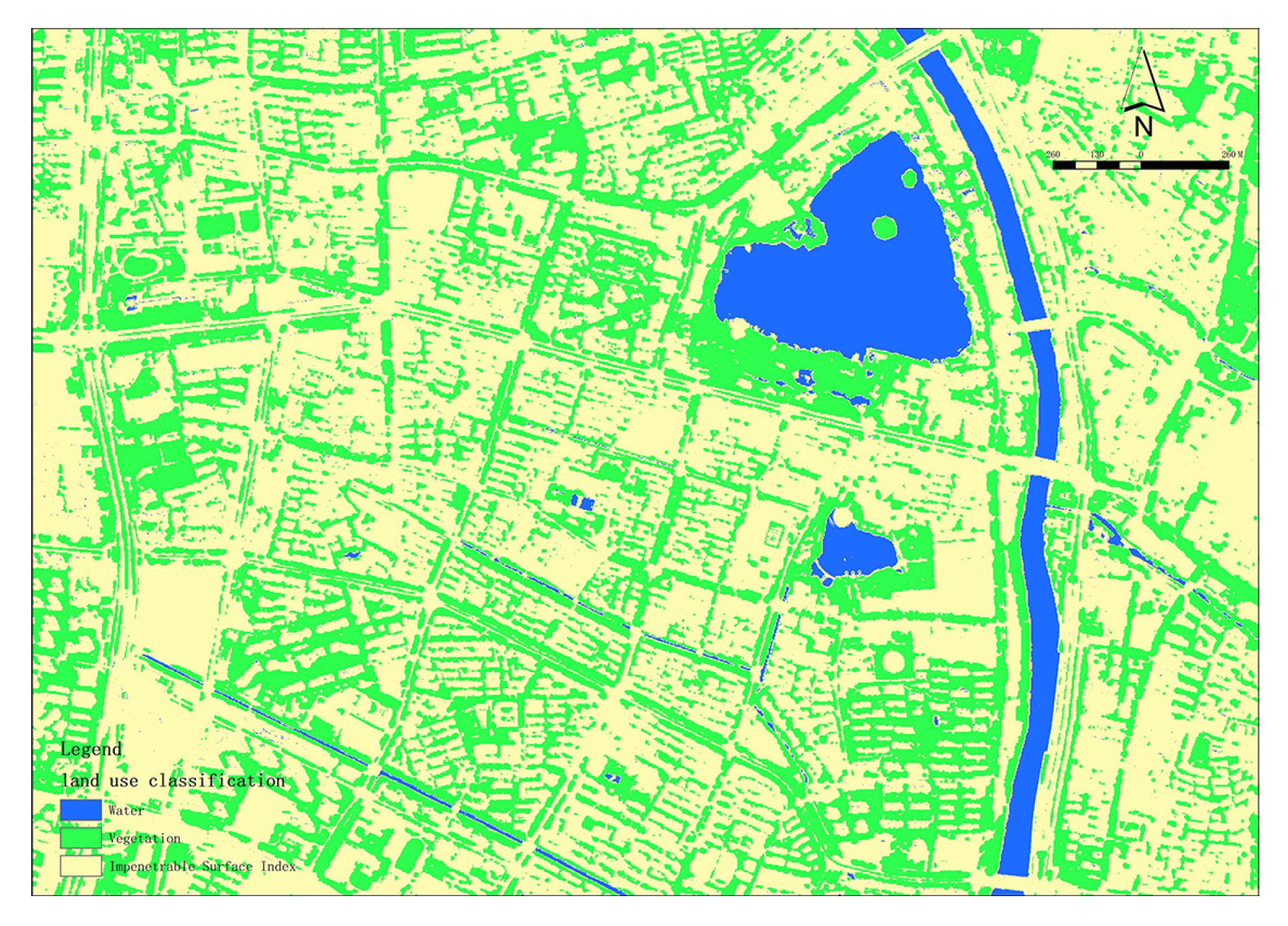
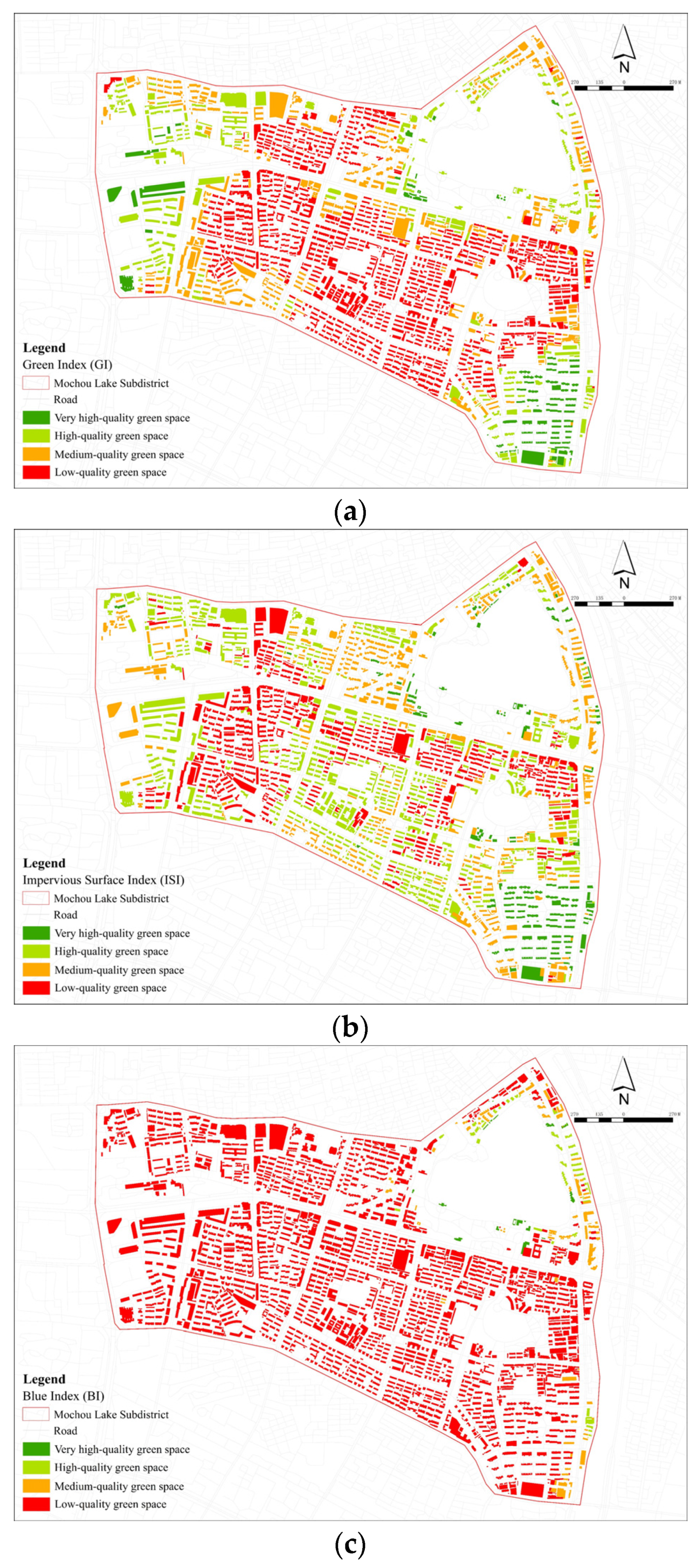
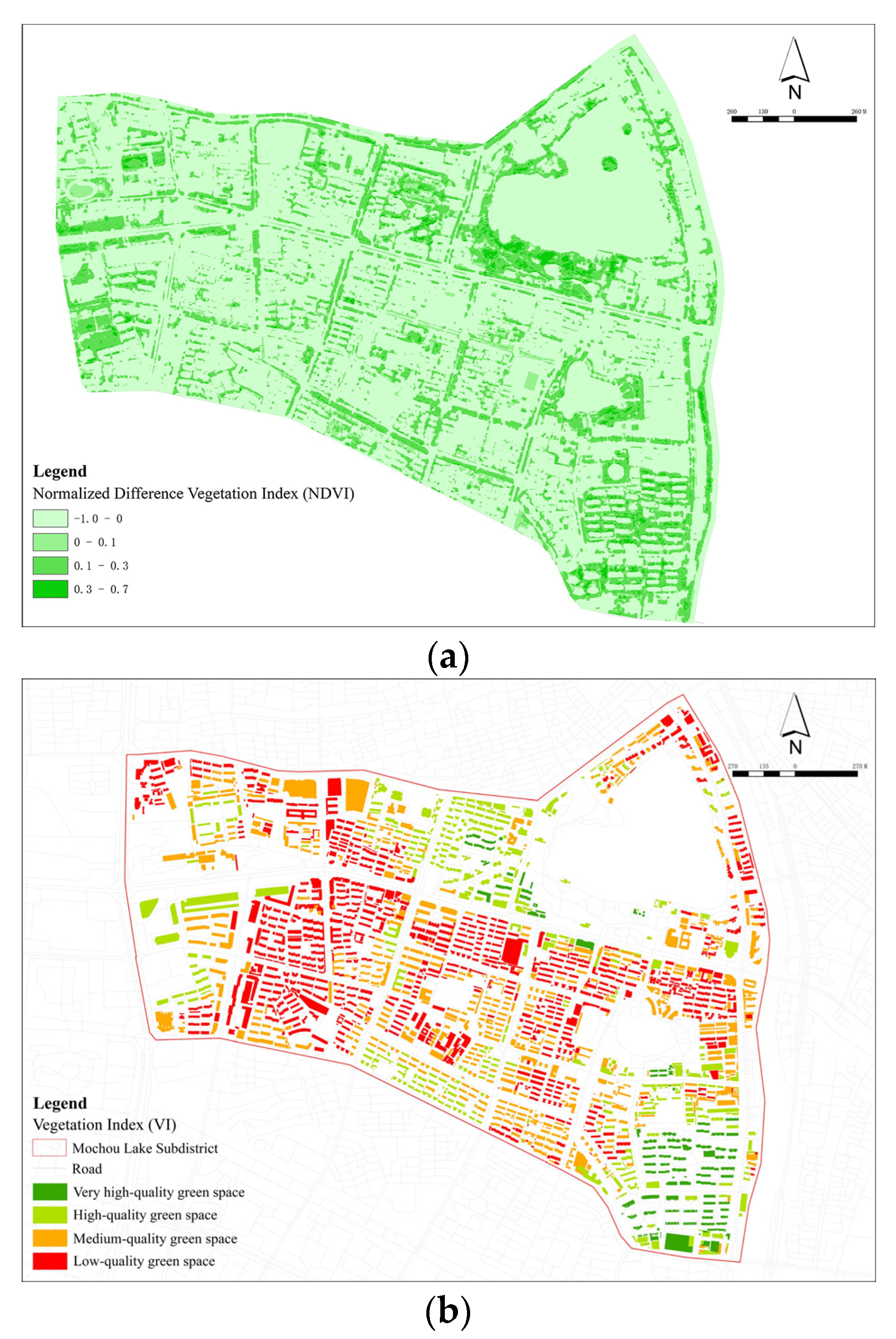
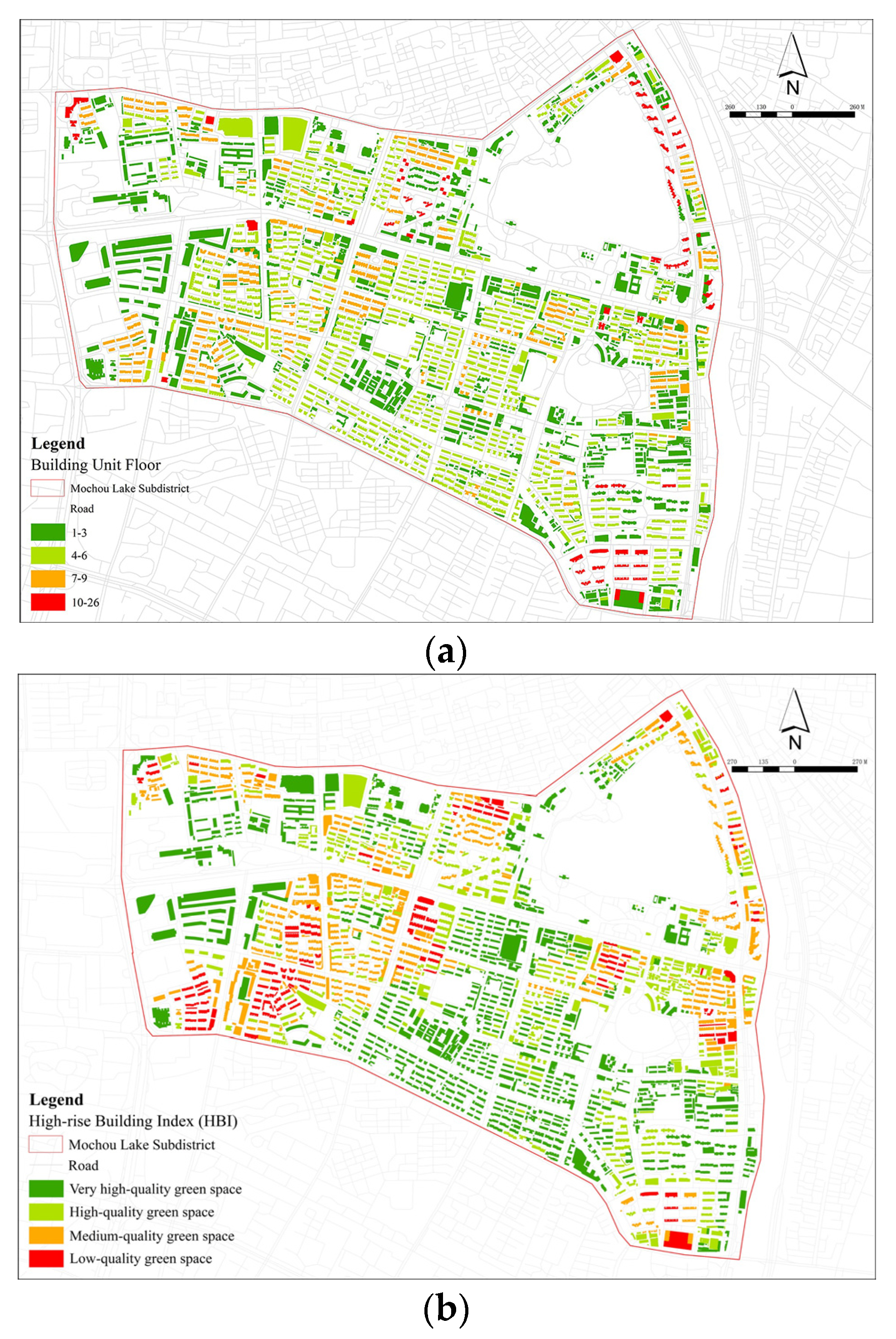
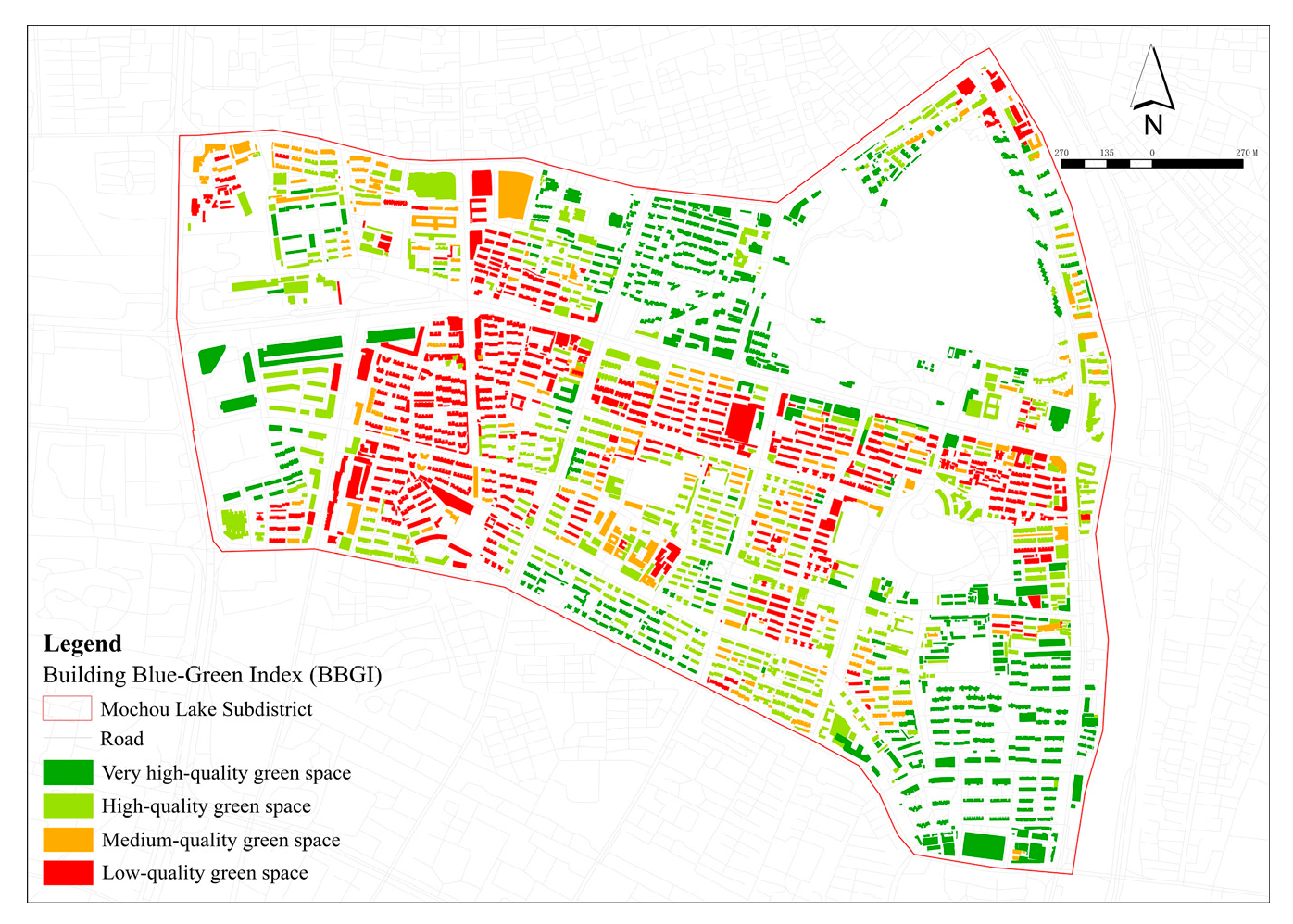
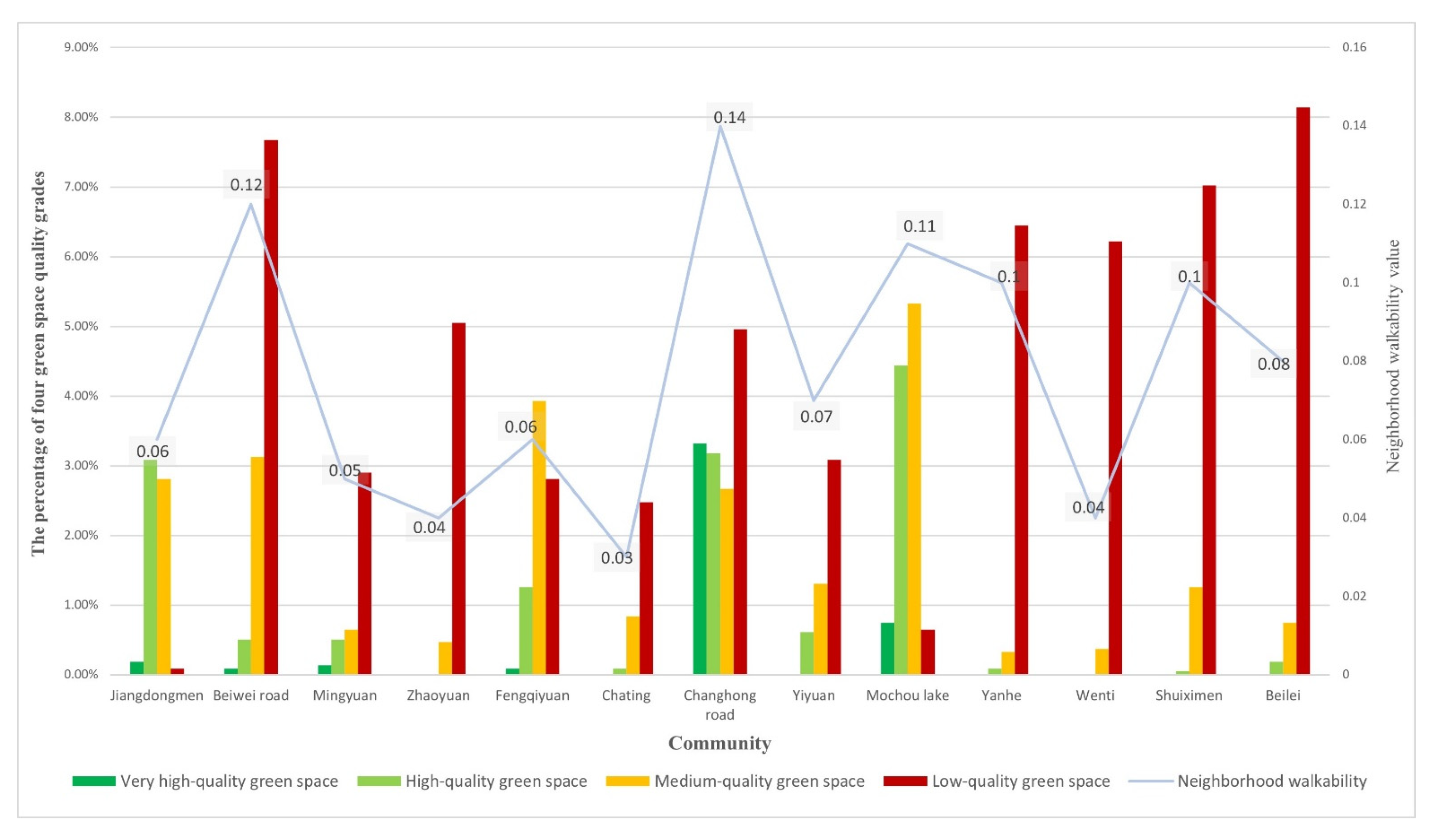
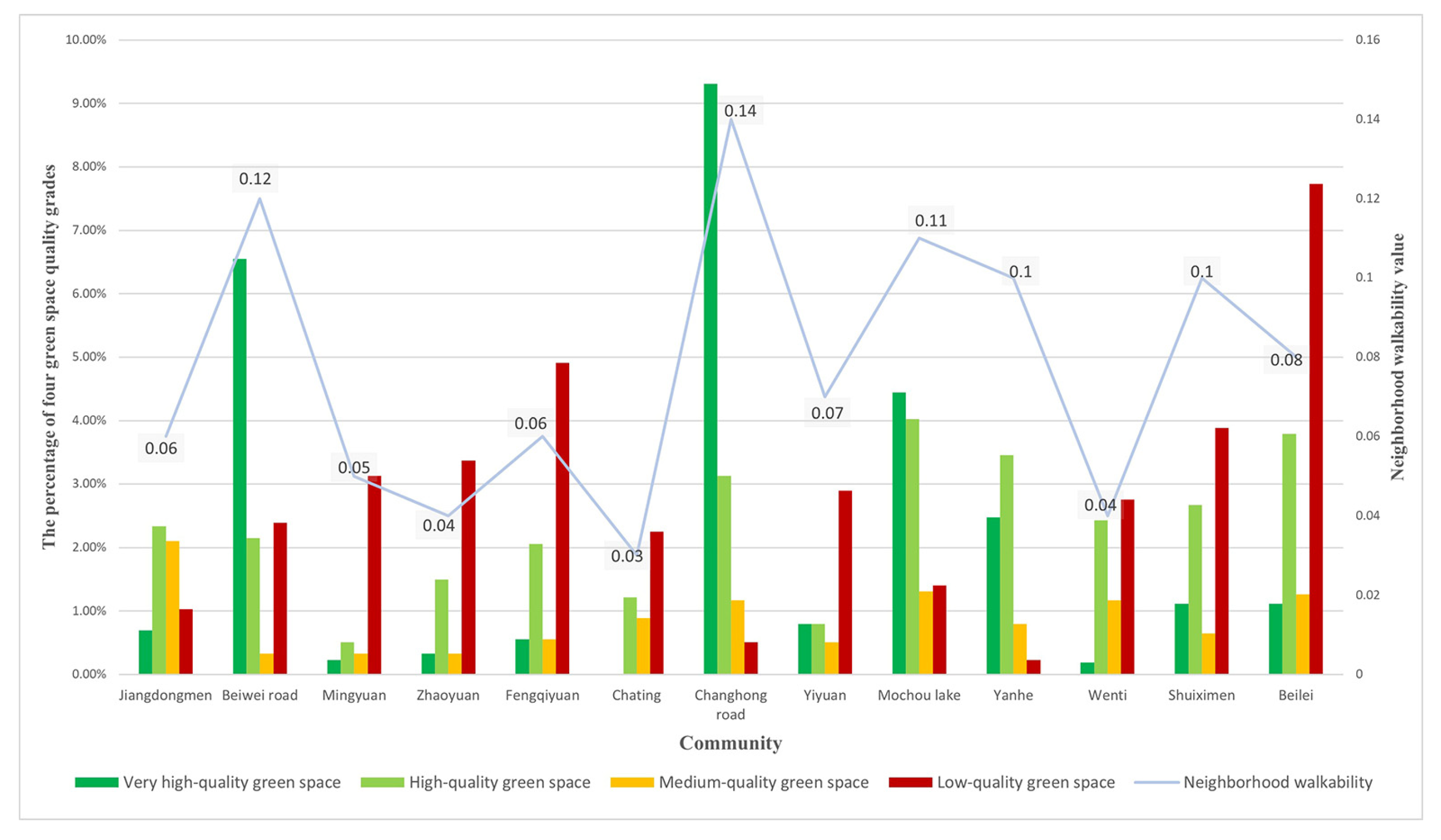
| Factor | Ratio/Average | Grade | Evaluation | Weights |
|---|---|---|---|---|
| Vegetation index (VI) | 0.54–1.34 | 7 | Very high-quality green space | 0.3367 |
| 0.34–0.54 | 5 | High-quality green space | ||
| 0.21–0.34 | 3 | Medium-quality green space | ||
| 0.00–0.21 | 1 | Low-quality green space | ||
| Green index (GI) | 0.50–1.00 | 7 | Very high-quality green space | 0.1956 |
| 0.30–0.50 | 5 | High-quality green space | ||
| 0.12–0.30 | 3 | Medium-quality green space | ||
| 0.00–0.12 | 1 | Low-quality green space | ||
| Impervious surfaces Index (ISI) | 0.00–0.13 | 7 | Very high-quality green space | 0.1087 |
| 0.13–0.36 | 5 | High-quality green space | ||
| 0.36–0.63 | 3 | Medium-quality green space | ||
| 0.63–1.00 | 1 | Low-quality green space | ||
| Blue index (BI) | 0.25–0.64 | 7 | Very high-quality green space | 0.2393 |
| 0.08–0.25 | 5 | High-quality green space | ||
| 0.02–0.08 | 3 | Medium-quality green space | ||
| 0.00–0.02 | 1 | Low-quality green space | ||
| High-rise building Index (HBI) | 0.00–0.02 | 7 | Very high-quality green space | 0.1197 |
| 0.02–0.06 | 5 | High-quality green space | ||
| 0.06–0.12 | 3 | Medium-quality green space | ||
| 0.12–0.27 | 1 | Low-quality green space |
| No. | Community (Number of Buildings) | Neighborhood Walkability | Evolution Index | Percentage of Four Green-Space Quality Grades | |||
|---|---|---|---|---|---|---|---|
| Very High-Quality Green Space | High- Quality Green Space | Medium-Quality Green Space | Low- Quality Green Space | ||||
| 1 | Jiangdongmen (132) | 0.06 | GI | 0.19% | 3.09% | 2.81% | 0.09% |
| BBGI | 0.70% | 2.34% | 2.10% | 1.03% | |||
| 2 | Beiwei road (244) | 0.12 | GI | 0.09% | 0.51% | 3.13% | 7.67% |
| BBGI | 6.55% | 2.15% | 0.33% | 2.39% | |||
| 3 | Mingyuan (90) | 0.05 | GI | 0.14% | 0.51% | 0.65% | 2.90% |
| BBGI | 0.23% | 0.51% | 0.33% | 3.13% | |||
| 4 | Zhaoyuan (118) | 0.04 | GI | 0 | 0.00% | 0.47% | 5.05% |
| BBGI | 0.33% | 1.50% | 0.33% | 3.37% | |||
| 5 | Fengqiyuan (173) | 0.06 | GI | 0.09% | 1.26% | 3.93% | 2.81% |
| BBGI | 0.56% | 2.06% | 0.56% | 4.91% | |||
| 6 | Chating (97) | 0.03 | GI | 0 | 0.09% | 0.84% | 2.48% |
| BBGI | 0 | 1.22% | 0.89% | 2.25% | |||
| 7 | Changhong road (302) | 0.14 | GI | 3.32% | 3.18% | 2.67% | 4.96% |
| BBGI | 9.31% | 3.13% | 1.17% | 0.51% | |||
| 8 | Yiyuan (107) | 0.07 | GI | 0 | 0.61% | 1.31% | 3.09% |
| BBGI | 0.80% | 0.80% | 0.51% | 2.90% | |||
| 9 | Mochou lake (239) | 0.11 | GI | 0.75% | 4.44% | 5.33% | 0.65% |
| BBGI | 4.44% | 4.02% | 1.31% | 1.40% | |||
| 10 | Yanhe (149) | 0.10 | GI | 0 | 0.09% | 0.33% | 6.45% |
| BBGI | 2.48% | 3.46% | 0.80% | 0.23% | |||
| 11 | Wenti (140) | 0.04 | GI | 0 | 0 | 0.37% | 6.22% |
| BBGI | 0.19% | 2.43% | 1.17% | 2.76% | |||
| 12 | Shuiximen (178) | 0.10 | GI | 0 | 0.05% | 1.26% | 7.02% |
| BBGI | 1.12% | 2.67% | 0.65% | 3.88% | |||
| 13 | Beilei (169) | 0.08 | GI | 0 | 0.19% | 0.75% | 8.14% |
| BBGI | 1.12% | 3.79% | 1.26% | 7.73% | |||
| Mochou Lake Subdistrict (2138) | GI | 4.58% | 14.03% | 23.85% | 57.53% | ||
| BBGI | 28.02% | 30.12% | 11.41% | 30.6% | |||
Publisher’s Note: MDPI stays neutral with regard to jurisdictional claims in published maps and institutional affiliations. |
© 2022 by the authors. Licensee MDPI, Basel, Switzerland. This article is an open access article distributed under the terms and conditions of the Creative Commons Attribution (CC BY) license (https://creativecommons.org/licenses/by/4.0/).
Share and Cite
Li, Z.; Chen, X.; Shen, Z.; Fan, Z. Evaluating Neighborhood Green-Space Quality Using a Building Blue–Green Index (BBGI) in Nanjing, China. Land 2022, 11, 445. https://doi.org/10.3390/land11030445
Li Z, Chen X, Shen Z, Fan Z. Evaluating Neighborhood Green-Space Quality Using a Building Blue–Green Index (BBGI) in Nanjing, China. Land. 2022; 11(3):445. https://doi.org/10.3390/land11030445
Chicago/Turabian StyleLi, Zhiming, Xiyang Chen, Zhou Shen, and Zhengxi Fan. 2022. "Evaluating Neighborhood Green-Space Quality Using a Building Blue–Green Index (BBGI) in Nanjing, China" Land 11, no. 3: 445. https://doi.org/10.3390/land11030445
APA StyleLi, Z., Chen, X., Shen, Z., & Fan, Z. (2022). Evaluating Neighborhood Green-Space Quality Using a Building Blue–Green Index (BBGI) in Nanjing, China. Land, 11(3), 445. https://doi.org/10.3390/land11030445






